New technique expands treatment options for superior limbic keratoconjunctivitis
The method involves conjunctival excision, amniotic membrane transplantation with fibrin glue and corneal epithelial debridement.
Click Here to Manage Email Alerts
 Thomas John |
Superior limbic keratoconjunctivitis is an ocular surface disease comprising recurrent inflammation of the superior bulbar conjunctiva with predominant involvement of the superior limbus, a papillary hypertrophy of the upper tarsal conjunctiva, and an adjacent corneal epithelial keratitis. The mechanical hypothesis is supported by the increased lid apposition in patients with thyroid-related exophthalmos, who have an increased incidence of superior limbic keratoconjunctivitis, at 3%.
Patients with superior limbic keratoconjunctivitis often present with red eye, foreign body sensation, burning, tearing and possibly photophobia. Conjunctival inflammation and thickening is often noted, especially at the limbus. Symptomatic treatment may be ocular lubrication with or without punctal plugs. Other treatments include thermal or silver nitrate cauterization of the superior bulbar conjunctiva, large diameter bandage contact lenses, pressure patching, topical trans-retinoic acid 0.1% and surgical intervention — namely, superior bulbar conjunctival recession or resection.
In this column, I describe a new surgical technique for superior limbic keratoconjunctivitis: superior bulbar conjunctival excision, amniotic membrane transplantation using fibrin glue and corneal epithelial debridement. This technique needs to be evaluated over a longer period of time in many superior limbic keratoconjunctivitis patients to assess the overall efficacy of the procedure and to check for any possible recurrences.
Conjunctival surgery
The preferred anesthesia for this procedure is topical anesthesia using 2% lidocaine jelly combined with monitored anesthesia care. Alternatively, retrobulbar, peribulbar or general anesthesia may be utilized. A bridal 6-0 silk suture is passed through the superior peripheral cornea, and the globe is rotated inferiorly toward the 6 o’clock position (Figure 1). The boundaries of the conjunctival excision are marked by spot cautery using a handheld disposable cautery and highlighted with methylene blue (Figure 2). The width of the excision is 1 mm greater on either side than the width of the conjunctival involvement, and the length of excision is 6 mm from the limbus. Hemostasis is achieved by using a disposable cautery and exposing bare sclera.
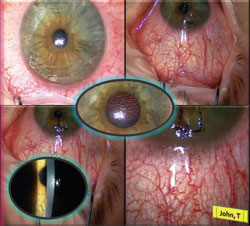 Figure 1. Intraoperative photographs of superior limbic keratoconjunctivitis. In addition to conjunctival changes, there is corneal epithelial irregularities seen both in the central and superior quadrants of the cornea (oval inserts). |
 Figure 2. Conjunctival and Tenon’s membrane excision with exposure of the bare sclera. Methylene blue staining of spot cautery helps demarcate the boundaries of the excision. The globe is rotated inferiorly using a 6-0 silk suture placed in the peripheral cornea close to the superior limbus. Methylene blue staining of the superior conjunctiva shows prominent staining of the abnormal conjunctiva. Images: John T |
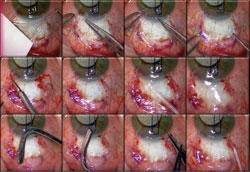 Figure 3. Top row: Amniotic membrane is placed to cover the bare sclera. Middle row: Interrupted 10-0 Vicryl sutures are placed at the four corners of the graft. Middle row, right: Fibrin glue is injected into the potential space between the sclera and conjunctiva, creating a pillow case appearance. Bottom row: A muscle hook is used to facilitate uniform attachment of the amniotic membrane to the bare sclera. The excess amniotic membrane is trimmed using a Vannas scissors. Fibrin glue is applied to the cut margins of the amniotic membrane to complete the procedure. |
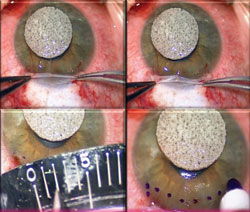 Figure 4. Top row: Amniotic membrane is folded back to expose the superior, peripheral corneal pannus. Bottom row: Pannus demarcation using a sterile marking pen. |
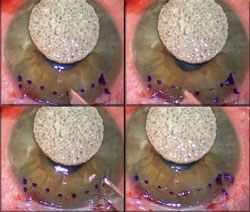 Figure 5. Pannus removal using a straight crescent blade. |
 Figure 6. Amniotic membrane is attached to the peripheral cornea using fibrin glue. |
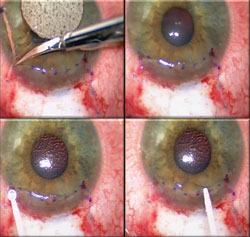 Figure 7. Top row: Excess amniotic membrane is trimmed using Vannas scissors. Bottom row: Fibrin glue is applied to the margins of the transplanted amniotic membrane. |
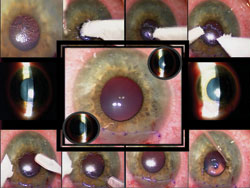 Figure 8. Corneal epithelial debridement and completed view of the procedure. |
Amniotic membrane is placed over the surface defect, with the stromal side facing the bare sclera, such that it covers the surgical defect (Figure 3, top row). The amniotic membrane is sutured at the four corners with 10-0 Vicryl sutures (Figure 3, middle row). A single 10-0 nylon suture is placed on the cornea at the 12 o’clock position. The two components of the fibrin glue are injected in the potential space between the amniotic membrane and the bare sclera (Figure 3; middle row, right) to balloon the amniotic membrane out like a pillow case. The convex surface of the amniotic membrane (pillow case appearance) is then ironed out using a muscle hook, thus flattening the amniotic membrane and facilitating uniform attachment to the bare sclera. The excess amniotic membrane is trimmed with curved Vannas scissors (Figure 3, bottom row), and additional fibrin glue is placed at the margins of amniotic membrane excision.
Corneal surgery
The strip of amniotic membrane at the limbus is folded on itself to expose the stromal side of the amniotic membrane and the superior peripheral cornea with the pannus (Figure 4, top row). The peripheral pannus is demarcated using a sterile marking pen (Figure 4, bottom row). Using a straight crescent blade, the pannus is excised (Figure 5). Fibrin glue is applied to the peripheral corneal strip and to the folded amniotic membrane (Figure 6). The amniotic membrane strip is then attached to the superior peripheral cornea. Excess amniotic membrane is excised (Figure 7).
The irregular central and superior corneal epithelium is then removed with Weck-Cel spears (Medtronic Ophthalmics) and a straight crescent blade, leaving a smooth, intact Bowman’s layer (Figure 8).
References:
- Kojima T, Matsumoto Y, Ibrahim OM, et al. In vivo evaluation of superior limbic keratoconjunctivitis using laser scanning confocal microscopy and conjunctival impression cytology. Invest Ophthalmol Vis Sci. 2010; 51(8):3986-3992.
- Mondino BJ, Zaidman GW, Salamon SW. Use of pressure patching and soft contact lens in superior limbic keratoconjunctivitis. Arch Ophthalmol. 1982;100(12):1932-1934.
- Theodore FH. Further observations on superior limbic keratoconjunctivitis. Trans Am Acad Ophthalmol Otolaryngol. 1967;71(2):341-351.
- Udell IJ, Kenyon KR, Sawa M, Dohlman CH. Treatment of superior limbic keratoconjunctivitis by thermocauterisation of the superior bulbar conjunctiva. Ophthalmol. 1986;93(2):162-166.
- Wright P. Superior limbic keratoconjunctivitis. Trans Ophthalmol Soc UK. 1972;92:555-560.
- Thomas John, MD, OSN Cornea/External Disease Board Member, is a clinical associate professor at Loyola University Chicago and is in private practice in Tinley Park and Oak Lawn, Ill. He can be reached at 708-429-2223; fax: 708-429-2226; e-mail: tjcornea@gmail.com.

